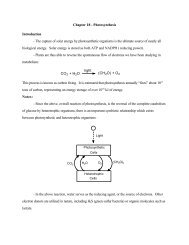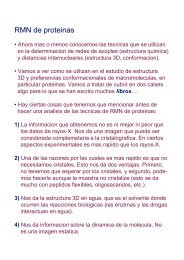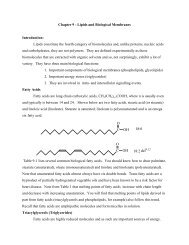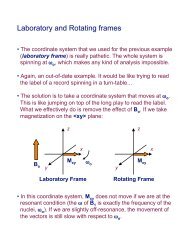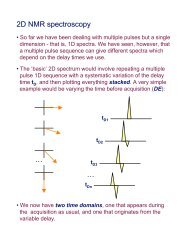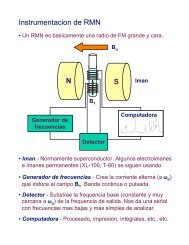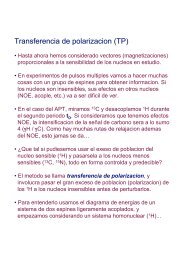Chapter16 - Glycolysis and Gluconeogenesis Topics you're not ...
Chapter16 - Glycolysis and Gluconeogenesis Topics you're not ...
Chapter16 - Glycolysis and Gluconeogenesis Topics you're not ...
Create successful ePaper yourself
Turn your PDF publications into a flip-book with our unique Google optimized e-Paper software.
PyruvatePyruvateATPMatrixADPOxaloacetateNADHCytoplasmNAD +MalateMalateNAD +NADHOxaloacetateNote that during this process mitochondrial levels of NADH decrease wherease cytoplasmic levelsincrease. In other words, reducing power is being exported from the mitochondria which is desirableunder conditions which favor biosynthesis (which gluconeogenesis is an example of).Note also that the last enzyme in gluconeogenesis, glucose-6-phoaphatase, is present only in those cellswhose metabolic duty is to export glucose, i.e., the liver <strong>and</strong> to a lesser extent the kidney.. Otherwise,glucose-6-phosphate can<strong>not</strong> leave the cell.III. Energy yield of gluconeogenesis:ATPPyruvateGTPOxaloacetateATP3-phosphoglycerateADPOxaloacetateGDPPEPADP1,3 bisphosphoglycerateTotal energy cost per glucose = (2 ATP + 1 GTP)/pyruvate X 2 pyruvate/glucose = 6IV. Regulation - There are two aspects of regulation. Entry of pyruvate into gluconeogenesis isregulated because pyruvate carboxylase requires acetyl CoA. Note that this is the anaplerotic reactionof the CAC so production of OAA can either refill depleted CAC levels or be converted into glucose.The choice here is determined by ATP levels. As an indicator of an energy-rich condition high levels ofATP will inhibit the CAC <strong>and</strong> direct OAA into gluconeogenesis <strong>and</strong> vice versa. Thus, an energy-richcondition diverts OAA into biosynthesis, <strong>and</strong> energy-poor condition increases CAC activity <strong>and</strong> the



